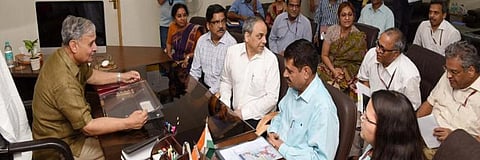India's data blockade: Certainly uncertain terrain
What do we know about our lives? Do we know ‘who is a poor’ in India? Or, who is unemployed and for what period? Do we know how much we spend in a month as that decides our position with respect to the poverty line? More to it, what is India’s poverty line? We certainly don’t know how many farmers have committed suicide in the near- or the long-term? We are yet to get a farmers’ situation report, which would indicate whether we are on track to double their income by 2022.
We are facing a peculiar data blockade. All the data sets mentioned above are done by government agencies like the National Sample Survey Office (NSSO). There has not been a single NSSO survey where the release has passed without controversy. The most contested being the unemployment data, first leaked to the media and formally released after months of delay. Recently Down To Earth reported on its website that NSSO’s survey on toilet access and usage is being withheld. The same survey would have indicated access to drinking water as well.
Perhaps for the first time in recent history it is so dark that we can't read any number that is written in the engine that drives our lives.
Data generation is the first step towards problem solving. As they say, what we can measure we can solve. All this is about us; our development and our well-being. Why should a government shy away from the responsibility of disclosing important indices with honesty? Development data is also a fundamental human right, more so in a democracy. This brings us to the other extreme, where government communication has become extremely data-centric. There is a number for every achievement. All government websites have a dashboard providing data on their flagship schemes. There is a concerted effort to quantify success through numbers.
Pull and push are being used together. So any data that shows the government in poor light is blocked. While the government is pushing its own “data” as a tool to create and boost its positive image. Positivity is the only acceptable currency. It is also a distinct historical trend of ruling parties in times of acute crisis. The most remarkable example at this point is the state of India’s economy. “It is the fastest growing economy.”
This engineered superlative, however misplaced or even factually incorrect, is being used by ministers with such evangelical vigour that it is serving the government even when everything points towards an economic slowdown. Every week the government is coming up with measures to revive the economy — an implicit acknowledgement of a crisis. But the crisis doesn’t seem to be bothering people. In the recently concluded assembly elections of Haryana and Maharashtra, economic slowdown was not even an issue despite both states having reported high unemployment, closure of industries and deep agrarian distress.
Television channels are, as usual, beaming faces of credulous voters expressing “happiness” about India growing at the “fastest rate”. Irrationality has reached a level where India’s growth rate is being compared to that of the US — which will of course be higher in case of the former. What the television is not telling you is the size of the US economy and the fact that low growth rates also fetch much more in the case of developed countries.
This has created an illusion of well-being. And since credible date is being blocked, ample space has been created to accommodate propaganda. And we subscribe to all this willingly.
This was first published in Down To Earth's print edition (dated 1-15 November, 2019)


